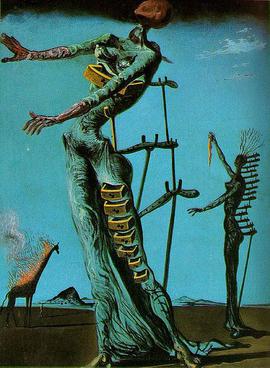
The equestrian statue of Marcus Aurelius is a bronze portrait from 176 CE. This sculpture, like most others from the imperial era, was an object of propaganda. Marcus Aurelius was a triumphant commander in the Roman military, as well as one of the most important Stoic philosophers. During the middle ages, this statue was saved from being melted down when it was mistaken as being a statue of Constantine, the first Christian emperor. Marcus Aurelius is depicted with thick, curly hair and a very full beard reminiscent of the philosopher portraits of Greek art and in the Imperial tradition of appearing rugged and unconcerned with vanity. In addition, Aurelius does not carry weapons and has no armor. Leaders were often shown as effortless conquerors that were victorious based simply on divine will. He is also reaching out to the audience in a sort of rhetorical address, another common element of Roman art. The sculptor skillfully balanced Aurelius and his horse so as to keep the viewer’s attention on the legendary leader.

The Catacomb of SS Peter and Marcellinus dates back to the late third to early fourth century. Several relics of SS. Peter and Marcellinus were found inside this Roman catacomb. The men buried in this catacomb were third-century Christians who were martyred for their faith. A Good Shepherd is shown at the center of the medallion, a round compartment in the ceiling. It is posed similar to sculptures from the classical period. The Good Shepherd represents a promise made by Jesus in the book of John. Surrounding the Good Shepherd are semicircular compartments depicting the story of Jonah from the Hebrew Bible. The left compartment shows Jonah being thrown from the ship, the right compartment illustrates Jonah being spit up by the monster, and the center compartment portrays Jonah in paradise. This story has been reinterpreted as a parable of Christ’s death and resurrection, one of the distinguishing factors of the Christian faith. Between each semicircular wall section, or lunette, stand several orant figures, or people with arms stretched out in worship and prayer. These figures are presumed to be images of other Christians buried in the catacomb.
When Christianity began to overtake Rome, art was quickly and directly affected in every aspect. Sculptures transformed from illustrations of history and leadership to depictions of stories from the Christian Bible. Elaborate, beautifully adorned exteriors of classical Roman buildings were exchanged for more grandeur on the interior that was intended to encourage worship of the Trinity, or Jesus, God, and the Holy Spirit. The catacomb of SS Peter and Mercellinus, for example, contains many illustrations of Bible stories and allusions to Christ. These images promoted the worship of God and aimed to draw attention away from man and his accomplishments. Roman art, on the other hand, was heavily based around leaders, achievements, and history. For instance, the equestrian statue of Marcus Aurelius shows the military commander and Stoic philosopher as a rugged conqueror. The statue demands respect and attention not only for its artistic merit, but also for the great legacy it represents.
On the other hand, both classical Roman and emerging Christian art are heavily rooted in the traditions of Greek art. For example, Marcus Aurelius is shown with one arm reaching out in a rhetorical address resembling the traditional philosopher pose of Greek portraits. Similarly, the Good Shepherd in the catacomb of SS Peter and Marcellinus is posed much like sculptures in traditional Greek art as well. In addition, both cultures expected viewers to be able to identify those depicted in each sculpture and image. This is why Roman art so often included distinguished leaders and historical elements. Likewise, the Trinity and other important stories from the Bible consumed Christian art.










